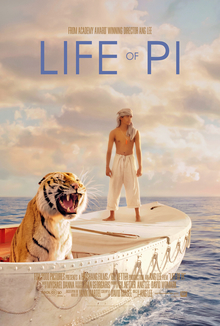Review 217: Life of Pi

It is also technical achievement and one of Ang Lee's best movies!
The plot is a genius work of art, it tells the story of a boy who goes on this amazing survival adventure but it tells it from a certain point of view: Pi's point of view, it's a story that's provoking, thought-wise and emotionally: it forces you to question the facts and figures of the story as you never know whats true and whats mythical, but in whichever one we choose to believe, we care about Pi and Richard Parker and they will make it back to safety. It is also a story that teaches us that the what we choose to believe in and the stories we hear in life depend greatly on our own point of view.
While at its core, Life of Pi may be a survival, adventure story, it’s also very philosophical in its structure. It’s a story told from two alternating POVs, the protagonist Pi in the flashback storyline and an unnamed writer (Rafe Spall) interviewing a grown up Pi (Irrfan Kahn) many years after the tiger in the boat story. This narrative technique of the intrusive narrator adds a documentary realism to the story, setting up, like a musical counter-point, the myth-making, unreliable narrator, Pi himself.
The film ultimately leaves us as an audience to ponder whether Pi’s story is an allegory of another set of parallel events.
Pi's story is so great, so epic, so amazing-so... unfilmable that it has to be seen to believed!
Much like the book on which it’s based, Life of Pi is primarily a story about Growth through Adversity as well as that Life itself is a story. As writer Gordon Houser eloquently put it: “That all life is interdependent and that we live and breathe via belief.”
The
bond between Pi and Richard Parker is an unlikely, almost unbeliveable
friendship, those two depend on each other to survive, Richard Parker
cannot be tamed and wants to kill Pi and Pi learns to communicate to
him.
Growth through Adversity: Ang Lee does a spectacular job of showing us as an audience the struggles to survive on our own after a big, massive disaster in the scenes were Pi and Richard Parker are floating in the middle of the open sea, they have to have their witts about and hope for the best and plan for the worst. The scenes also do a great job of showing the loneliness of the two character and what it's like for them or anyone to have experienced that much loss, to be without people or any kind of social interaction for that long.
Ultimately it’s mainly through his courage and perseverance that Pi manages to stay alive for so long. Every time he just staggers on that raft and every time it looks like he's gonna die he survives.
He also uses a guide book he found in his life boat for help.
Another prominent theme throughout the film seems to be believability: Director Ang Lee forces us as an audience to question to believability of Pi's story. Throughout the film as the older Pi tells his story to the unnamed writer who ultimately has to choose which story he prefers.
Ang Lee's direction is precise/unobtrusive, the cinematography is gorgeous and captures the beauty of all the different locations as well as the open seas. The special effects are dazzeling, the creature design is fabulous, the score by Mychael Danna is beautiful and superbly complements the films lushly rich visuals. the scenery is breathtaking, the locations are imaculate, the production design is incredible (it mainly takes place on a raft and a life boat, but the overall look of the film is genuinly spectacular), the costumes are majestic, the make up is rich and beautifully detailed, there are some brilliant scenes that excite the intellect as well as the adrenaline glands and the sound effects are precise.
The acting is also excellent from what little stars that Lee uses throughout the film. Newcomer Suraj Sharma is easily the standout who is alone by himself for the duration of the films 127 minute run time. He is required to carry this movie on his two shoulders and he does so effortlessly considering he's acting opposite remarkably lifelike CGI animals, namely the instantly iconic Bengal tiger, Richard Parker whose very much a character in his own right.
Much like Tom Hanks in Cast Away and Will Smith in I Am Legend, he’s the sole star of this film with only an animal for company.
Irrfan Khan is also fabulous as the adult Pi, reflecting on his extraordinary life and contemplating how it has changed in fundemental ways. He also brings an right amount of enigma, mystery and intrigue to the part as we as audeince can never really tell if he's telling us whats really happened or if he's fabricating the story.
Rafe Spall is really likeable as the writer. He provides a window for us as an audience to experience Pi story wether or
Life of Pi is (as Roger Ebert put it) a miraculous achievement of storytelling and a landmark of visual mastery, 5/5.
The Anonymous Critic.
Comments
Post a Comment